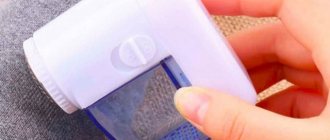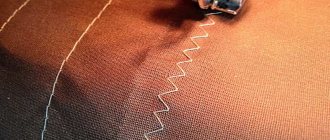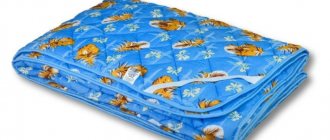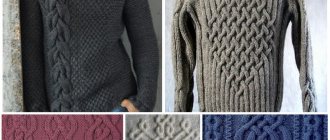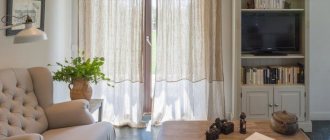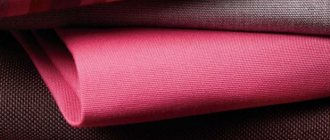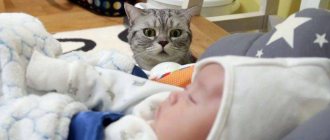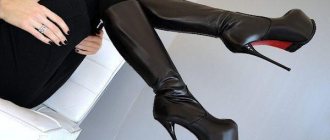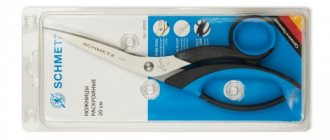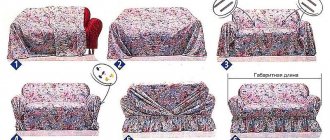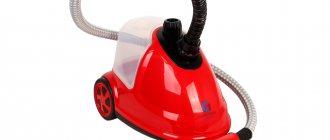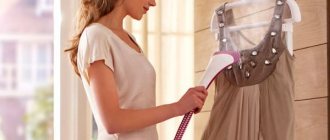To handle the edges of knitted fabrics, a cover stitching machine was developed. It makes a neat stitch that does not deform the device and stretches along the length. The operating principle of such a technique will differ from a standard sewing machine: the device produces a chain stitch, which implies the absence of a bobbin case in its design.
To facilitate the selection of cover stitching machines, a list of the most functional products has been compiled. Among them there are both simple devices and more productive models. When compiling the rating, we took into account the purpose of cover-stitching machines, their advantages and disadvantages, expert assessments and user reviews.
Comparison of the best cover stitching machines
The table below shows the 10 best models of cover stitching machines that performed the best.
| Model | Thread tension control | Weight, kg | Power consumption, W | Design Features | price, rub. |
| Elna 444 | Auto | 9 | 110 | Foot pedal, soft case, color coding, removable arm platform, thread cutter, auto-threading looper | 28300 — 35000 |
| Janome Cover Pro D Max | Manual | 8.1 | 80 | Looper thread tension control system, accessory compartment, fabric pressure adjustment, soft case, color coding, removable sleeve platform, thread cutter | 30400 — 39000 |
| Elna easycover | Auto | 8.7 | 80 | Compartment for accessories, removable arm platform, cut-off knife, thread cutter, auto-threading looper | 32400 — 39100 |
| Leader VS 400D | Manual | 7 | 105 | Tray for scraps, removable sleeve platform, fabric pressure adjustment, color marking | 26900 — 31000 |
| Janome Cover Pro 7 | Manual | 9.5 | 90 | Fabric pressure adjustment, accessory compartment, soft case, color coding | 33900 — 38900 |
| Merrylock 009 | Manual | 7.9 | 100 | Trim tray, soft case, color coding, carrying handle, pedal, auto looper threading | 18400 — 22200 |
| Janome Cover Pro II | Manual | 8 | 90 | Puncture force stabilizer, thread cutter, soft case, removable sleeve platform, color coding | 29500 — 38900 |
| Brother CV3550 | Manual | 7.6 | 67 | Compartment for accessories, removable arm platform, soft case, thread cutter, auto-threading looper | 37900 — 40400 |
| Merrylock Cover Stitch Auto | Auto | 7.47 | 120 | Carrying handle, accessory compartment, color coding, soft case, puncture force stabilizer, auto-threading looper | 20100 — 24600 |
| Family MasterLock 8000W | Manual | 10.5 | 90 | Removable sleeve platform, soft cover, puncture force stabilizer, color coding | 31500 — 41900 |
Comparison of characteristics of the presented models
Below is a small rating of models of coverstitch machines from different manufacturers with a brief description, characteristics, and ratings for different price categories.
Budget models
| Model | Characteristics |
| Janome CoverPro 1000CP (CoverPro II) Flat-stitch cover sewing machine with rich technical equipment. The model works well with textiles of different thicknesses. A reinforced seam system has been introduced, which significantly reduces the sagging of the looper thread, thereby making the seam more durable and dense. Characteristics:
Advantages:
Flaws:
| |
| Merrylock Cover Stitch Auto A model of a cover stitching machine with fairly high speed and power. Makes even, skip-free stitches on any fabric. Characteristics:
Advantages:
Flaws:
| |
| Singer 14T970C COVER STITCH An excellent 3-needle stitcher that produces high-quality stitches on any materials. Characteristics:
Advantages:
Flaws:
|
| Model | Characteristics |
| Minerva M2000C Flat-stitch model from an Austrian manufacturer with thread tension regulators and automatic adjustment mode. Characteristics:
Advantages:
Flaws:
| |
| Janome Cover Pro 7 This model has received many positive reviews from home craftswomen and professionals. The device is of excellent quality and comfortable thread tension adjustment. Characteristics:
Advantages:
Flaws:
| |
| Brother Cover Stitch 3550 A stitcher that makes it possible to process knitted fabrics at a professional level. Manufacturers used the latest innovative developments here, a new differential fabric feeding system. Characteristics:
Advantages:
Disadvantages: high cost. |
Premium models
| Model | Characteristics |
| Juki MF-7723-U10-B48 The industrial device is designed to create flat seams and can ideally work with knitted textiles of different thicknesses. Characteristics:
Advantages:
Disadvantages: high cost. | |
| Janome Cover Pro 7000 CPS A model with a provided seam reinforcement system, no vibration during operation. Characteristics:
Advantages:
Disadvantages: unit weight 9.5 kg. | |
| TYPICAL GK 335-1364-11 Industrial high-speed cover stitching machine for high-quality processing of light and medium knitted materials. Characteristics:
Advantages:
Flaws:
|
Choosing a machine is really difficult, so let’s look at the TOP 7 presented in the comparison table.
| Model | Power, W | Number of operations | Sewing speed, stitches/min | Price, rub |
| Merrylock 009 | 100 | 4 | 1300 | 15 670 |
| Brother 2340CV | 90 | 5 | 1000 | 21 460 |
| Janome Cover Pro II | 90 | 4 | 1000 | 21 490 |
| Minerva CS M1000Pro | 120 | 5 | 1200 | 28 719 |
| Elna 444 | 110 | 14 | 1000 | 29 990 |
| Brother CV3550 | 67 | 7 | 1000 | 39 900 |
| Juki MCS-1500 | 115 | 7 | 1350 | 49 500 |
Best lists
The list indicates the main technical indicators of cover stitching machines, highlights the advantages and disadvantages of the products, and notes user reviews. Let's study the best devices by category:
- The most functional.
- The most economical.
- The most convenient.
Let's take a closer look at this assortment.
Janome Cover Pro II - the most functional
A convenient cover stitching machine that works with different types of knitwear, producing an even and high-quality stitch. The device operates without the use of a knife, the sewing speed is 1000 rpm. The presser foot rises to a maximum of 7 mm, which makes it possible to make seams on thick fabric. The number of threads in the device is 4. To sew bulky items, you can buy a side table.
A removable platform is provided for processing sleeves and trouser legs. This will greatly facilitate the work. Reliable stitching is achieved due to the presence of a special STS seam reinforcement system. The threads practically do not sag, the elasticity of the stitching is not lost. Hints on the case will help you quickly navigate the settings. The device allows you to create high-quality designer products from knitwear.
Merrylock 009 – the most economical
A fast car that has a universal purpose. Quiet and comfortable to operate, rotates at 1300 rpm. It makes fairly even stitches, and the automatic threading of the looper will make the work as comfortable as possible. The product runs smoothly and works effectively with different types of fabrics.
The hinged looper cover provides clear visibility and easy threading. Color-coded threads make it easy to thread the looper. There is a sticker on the lid with a filling diagram. By adjusting the fabric pressure, you can easily sew thick and thin types of fabrics.
Elna 444 – the most convenient
A comfortable cover stitching machine designed for processing the bottom and neck of knitted items. Despite all the functionality, it is lightweight and compact in size. The maximum number of threads can be threaded is 4. The machine is easy to use thanks to easy access to parts.
Ergonomic shape and unique features provide comfortable sewing. The product is equipped with a removable sleeve platform, which allows for the treatment of remote areas. The ruler on the body helps you accurately measure the amount of fabric you need. Longitudinal thread tension regulators make it easy to adjust the model.
Operating principle and application of cover stitching machines
Machines of this type are quite simple in design and comfortable to operate.
They easily cope with dense, thin, elastic, split tissues, making flat elastic seams. These seams are used for:
- hemming the edges of knitted T-shirts, T-shirts;
- sewing in elastic bands, edgings, braid, lace;
- sewing bed linen, towels, tablecloths, curtains, and other types of home textiles;
- processing of collars, sleeves, hems or cut points in products made of knitwear or stretch fabrics.
Design
Their special configuration can ensure uniform flat stitches, seams obtained through the operation of loopers and 2-4 needles. To do this, each model has a certain set of needles in the top row, and a looper is located at the bottom.
Typical cover machine
Also, in many models of these machines, expanders (thread guides) are located at the top of the body.
The needles located in the top row enter the fabric, the looper, removing the threads from them, moves to the extreme position. When the needles re-enter, they remove the threads from the looper and return to their original position. Only cover stitching machines (they are also called flat-stitch machines) can make seams that will not tear when stretched, which, like rubber, stretch right along with the fabric.
Only cover stitching machines perform “stretch” seams
The best manufacturers of cover stitching machines
Before choosing a quality product, you should familiarize yourself with the best product manufacturers. Most popular brands:
- Merrylock. Manufactures household and professional equipment that performs the option of overcasting sections of textile products.
- Janome Sewing Machine Co. Ltd. Produces sewing equipment, accessories and software for it. The technique is suitable for beginners and professionals.
- Bernina International AG. A Swiss brand that produces precise and durable cover stitching machines.
- Minerva. A brand that produces reliable and functional equipment at an affordable price.
- Tovaro. A Swiss brand that produces high-quality and innovative products.
- Juki. A Japanese brand that produces household and industrial sewing equipment. During production, innovative developments are used and original high-quality parts are used.
Where to buy a cover stitching machine?
This sewing equipment can be purchased in specialized stores, and you can also order online. In the first option, the advantage will be that the product can be seen with your own eyes, touched, and tested for functionality. Purchasing through an online store will give you a chance to get a good discount or promotion with attractive conditions.
“When buying a cover stitching machine, take care of purchasing high-quality threads that are suitable for this model and specific types of fabric.
Criteria for selecting a cover stitching machine
Before purchasing a cover stitching machine, you should pay attention to the main selection criteria:
- Distance between needles This parameter determines the stitch width. Standard parameters are 5.5 (2 needles) and 6.5 mm (3 needles). Single-needle with 2 threads are used for regular stitching of parts, two-needle with 3 allow you to make stitches of the same type, and three-needle with 4 allow you to make different types of seams.
- Transporter and platform. A separate conveyor is installed to collect and stretch the stretch material. Complex elements are processed on platforms.
- Thread tension. Performed in 2 modes: manual and automatic. Manual is suitable for experienced seamstresses with proper dexterity. Automatic is much simpler and makes it possible to prevent errors.
- Weight and power. Modern devices are equipped with a powerful mechanism and electronic control, which ensures the correct functioning of the product. The higher the power, the more electricity is needed. The weight of cover stitching machines is 5-12 kg.
- Equipment. The standard kit includes a protective case. Also included are small and large screwdrivers, cleaning brush, looper, spool holder, needle set and thread storage net.
- Noise level and ease of movement. Smooth running and low noise during operation are typical only for models from the middle and premium class.
Professional cover stitching machines
Elna 444 - with quick help system
Even experienced seamstresses at home and in industrial conditions need recommendations from model developers. Despite working with only 2-3 threads, the device is multifunctional.
The ability to adjust the cutting width of the material, the presence of a free sleeve and a thread cutter has a beneficial effect on the number of operations performed.
It is also convenient that the adjustments are prudently located outside and there is no need to use an additional tool to change the settings.
Advantages:
- power 110 + 15 W for lighting;
- the looper is self-threading;
- 14 operations available;
- you can make 7 types of stitches;
- the model performs 1000 stitches/min.;
- the presser foot has a pressure regulator;
- There is an additional work table.
Flaws:
- average cost 32,000 rubles;
- very brief instructions;
- Needles do not thread automatically.
High speed Juki MF-7723-U10-B48
The unit is designed to create flat seams and works ideally with knitted fabrics of different thicknesses and textures. Increased productivity involves constant replenishment of threads and special oil for lubrication.
Advantages:
- industrial type;
- power 400 W;
- works with 5 threads;
- chain stitch;
- has an upper and lower cover;
- the model has a productivity of 6500 stitches/min.;
- automatic lubrication.
Flaws:
- cost from 50,000 rub.
How to choose a cover stitching machine for your home?
Nowadays, when the market is overflowing with offers and brands, and people do not stand in lines for quality cars, all sorts of variations of the same equipment appear on the shelves, there are budget options, there are expensive ones, but how to choose the right one?
Cars on Yandex.market
In this section we will tell you all the nuances when choosing a car, how best to buy and much more! It’s worth starting with the varieties in order to immediately decide what we need.
Varieties
Coverstitching machines can be divided according to a large number of criteria; we highlight 6 main parameters that will help us with the choice:
• Number of threads - there are the following variations: 2, 3, 4 and 5 threads, the number affects the variety, 2, 3 and 4 are suitable for home sewing; 5-thread threads are most often used in studios and factories
• Number of needles (from 1 to 3) - this criterion, like the previous one, determines the variety of stitches, more needles = larger stitch width.
• Types and number of stitches - although most people use 2-3 lines, sometimes you want to try something new or decorate your product
• The presence of an automatic thread tension regulator - on electromechanical types of flat-bed sewing machines you have to manually adjust all settings; on more expensive options there is the possibility of automatic adjustment
• Distance between needles - affects the maximum stitch width
• The height of the presser foot stroke is an important criterion that many do not pay attention to, although the maximum thickness of the fabric that we can sew depends on it; usually this parameter varies from 3 to 15 mm.
Where to buy?
When purchasing any sewing equipment, it is important to adhere to 2 simple rules:
1. Never buy cheap models in hypermarkets - in 90% of cases they are junk, with plastic running parts, which will last no more than a year and cannot be repaired.
2. If you have the opportunity to buy the model you like in your city, rather than ordering from online stores, do it, even if there is a slight overpayment. Why? Yes, it’s very simple, when you buy a machine in a specialized store, they will tell you all the nuances and let you use it (so stock up on pieces of unnecessary fabric), they will also show you how to thread it and set it up. Do not discard defective products! I still remember my bitter experience: I ordered a rather expensive model on the Internet, waited for it for quite a long time, and, unfortunately, it arrived with an obvious defective case (in some popular online stores they don’t even check them before shipping), I had to drag it to mail and send it back at your own expense, then wait for a new one.
It probably makes no sense to talk about the fact that you need to buy only from trusted online stores, but I will note that often the owners themselves post reviews on them so that the products are sold more successfully. Therefore, it is worth looking at reviews on independent sites (although fake reviews about sewing equipment are also often uploaded there).
Brands
We have separated brands into a separate item for a reason. If previously branded equipment was a luxury or a shortage, had a high cost and it was very difficult to find a suitable service, then today everything is far from the case!
Brands
Even branded cars cost reasonable money, making it easier to find a technician who will repair your equipment. There will also be no problems with the parts; they are sold in any company store.
Cover stitching machine Juki MCS-1500
Photo: market.yandex.ru
The Juki MCS-1500 cover stitching machine is a machine for processing cuts on knitwear, such as necklines and sleeves on T-shirts, as well as making decorative seams on knitwear. The MCS-1500 is equipped with a standard set of operations, namely, four- and three-thread cover stitches and a two-thread chain stitch. To sew the most capricious knitwear, you can use the presser foot pressure adjustment and the differential fabric feed setting.
Cover stitching machine Juki MCS-1500
Peculiarities:
- Differential feed
- Thread cutter
- Adjusting the fabric pressure
- Number of threads 3, 4
- Types of seams: cover stitch, chain stitch
- Stitch length 1 - 4 mm
- Stitch width 3 - 5 mm
- Maximum presser foot lift height 10 mm
- Maximum sewing speed 1350 stitches/min
- Needle type 130/705 N (HAx1SP)
- Color coding
What to look for when choosing?
When choosing a cover stitching machine, you should pay attention to the indicators that are necessary for you.
- If you plan to use the machine daily and in large quantities, look for a model with high power and fast operating speed.
- You need a multidisciplinary machine - look for machines that can process different types of fabrics.
- The large number of stitches and operations that can be performed is suitable for beautiful work with a variety of fabrics.
- For beginners, the best model is one with possible hints, automatic needle threader and tension control.
- Machines with an automatic fabric cutter require a shut-off function.
- Of course, it is necessary to take into account such indicators as engine noise and smoothness. Machines that run smoother operate much longer without breakdowns.
- For home use, you should choose more universal models - with an overlock function and the ability to sew ordinary fabrics.
- Machines with an increased working area and a removable sleeve mechanism are also convenient. Such devices will allow you to conveniently work with large and slippery fabrics and process the most inaccessible places in products.
How does a cover stitch machine work and what is a flat stitch?
Despite the fact that some coverstitch machines reach large sizes, the principle of their operation is extremely simple. There are several needles designed for upper threads, a lower looper and an upper thread handler (if provided by the manufacturer). A design with such knots is called a regular 5-thread cover stitch. Even the simplest overlocker for household purposes is a little more complicated.
You might be interested in Sewing a mattress for a newborn stroller yourself
Types of flat seams
When lowering the needles into the fabric, the looper removes the upper threads and moves away in its direction. The needles repeat the cycle, gradually descending into the fabric. This time they are already removing the threads from the looper. This is enough to form one flat stitch (seam). Despite its simplicity, you can configure dozens of values for the operation of the machine. This includes adjusting the installation of needles and loopers. This is recommended only for experienced users.
Stretch fabric
